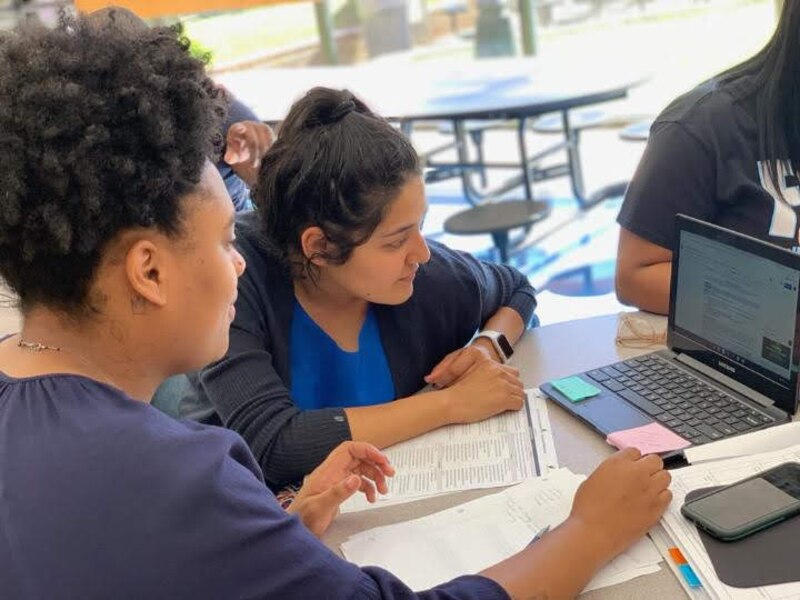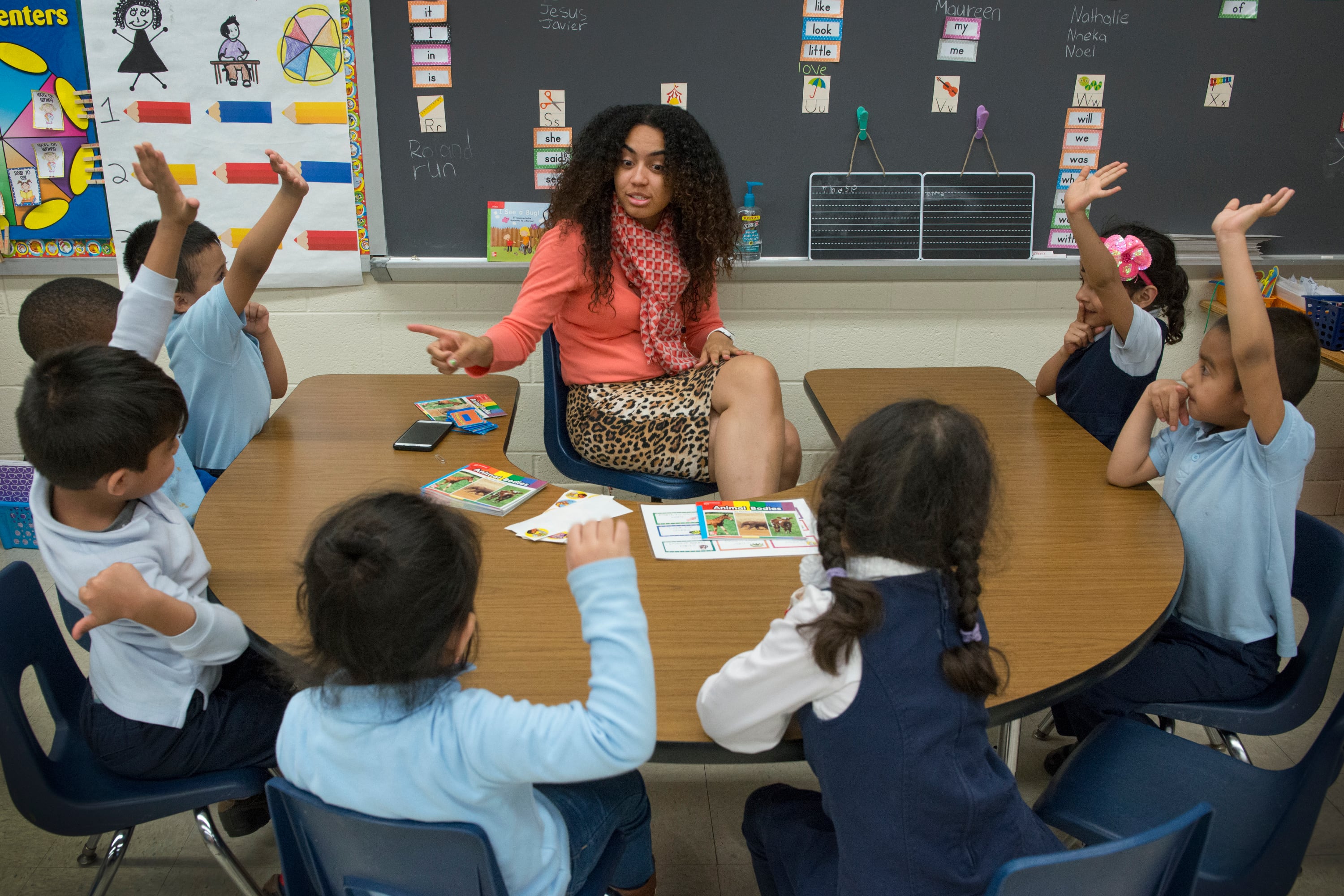Teach for America is known for its summer training “institute” — a crash course in teaching for thousands of incoming educators, often with mornings spent teaching summer school students and nights spent planning lessons in local college dorms.
But when the coronavirus pandemic arrived in March, TFA leaders knew the organization’s training for some 3,000 new corps members would need an overhaul.
This summer, “institute” is going virtual. For four and a half weeks, the incoming teachers will get about four hours a day of live training by video, then spend another four hours learning on their own. Only then will they decamp to the communities where they’ll work, and what happens next — traditional or virtual summer school, small group instruction, or practice classes made up of adults — will depend on the location and the spread of the virus.
“Every teacher preparation program is going through the exact same thing right now,” said LaNiesha Cobb Sanders, a senior vice president at TFA who oversees the summer training. “It is being responsive to the environment that we’re in.”
TFA is one of many non-traditional teacher preparation programs that rely on the summer months to give new teachers experience in front of students. Some programs are working to figure out how to capture some of that with virtual summer school, while others say they’ll focus on skills like lesson planning in the short term and double down on coaching in the fall.
Either way, few educators will get the same hands-on experience they would have before the pandemic — one more way the coronavirus is changing what it means to be a teacher across the U.S.
“All our training has been brick and mortar,” said Michael Whitmore, who oversees teaching and learning for the Academy for Urban School Leadership, which has run a residency program in Chicago since 2002. The academy now has a plan for residents to take college coursework online and train virtually. But at first, he acknowledged, he and other leaders were at a loss.
The program typically “is very hands-on, very face to face and very coaching-forward,” he said. For training and mentoring, “we never anticipated using Zoom.”
What training will look like
A few teacher residency and fellowship programs — which rely more heavily on summer training than university teacher preparation programs — have had to scale back entirely. The New York City Teaching Fellows program, for example, planned to have 475 fellows in its summer program, but coronavirus-related budget cuts mean it will have just 75. TNTP, a national nonprofit that runs teacher fellowship programs across the country, decided not to launch its Minnesota program as planned.
But most programs are continuing, while moving their training programs online and adapting in other ways.
Teach for America, TNTP, and the Arkansas Teacher Corps, for example, aren’t requiring new teachers to move to where they’ll be teaching as quickly.
Knowing it will be hard for new teachers to focus on a screen all day, many programs will offer shorter virtual training sessions that give teachers more time to work in small groups or on their own. They’ll be putting extra emphasis on learning how to support students socially and emotionally, as students and their families may be under extra stress in the fall. And they’re looking for ways to help new teachers connect with one another through events like virtual coffee hours and potluck meals.
The training itself is changing, too, to help get teachers ready to work in both traditional classrooms and in virtual settings — and to switch back and forth if a new wave of the coronavirus closes school buildings in their community. That means learning to use tools for video chatting, recording video demonstrations, and posting assignments.
New teachers also will have to practice interacting with students in a socially distanced classroom.
“Some of our typical teacher moves and the things that we would have done, such as using proximity to get close to a child if we needed them to refocus on class, will no longer be possible, at least not for the foreseeable future,” said Samantha Hoare, who leads TFA’s Miami program and heads up the national summer training. “We actually need to shift some of our training. We can’t just say: ‘Here’s exactly [how] you would do it x way.’”
Several programs are also planning to ask new teachers to watch video examples of how to teach a lesson remotely, or to record themselves practicing key teaching skills, even without students.
The 99 fellows expected to go through TNTP’s Indianapolis Teaching Fellows program, for example, will use a tool called Flipgrid to record themselves as if they were in the classroom and then get feedback from coaches or other fellows.
“We might ask a fellow to demonstrate: What does it look like as you’re standing in your doorway, there are students in the hall getting ready to come to class, and some students have already entered class?” said Whitney Newton, who directs the Indianapolis program. “How are you getting students started on the academic task quickly? Are you greeting students in a way that builds relationships? And what does your ‘teacher voice’ sound like if you see something that’s not quite in line with your expectations?”
The challenges ahead
But there’s no denying that one key part of traditional training — getting educators-to-be in front of a classroom of students — will be missing this summer if school buildings are closed and it’s deemed unsafe for large groups to gather.
That matters because classroom management skills seem to be predictive of teacher effectiveness, especially for novice teachers, according to Dan Goldhaber, a professor at the University of Washington who has studied teacher preparation and teacher quality.
“One of the hardest things for a first-year teacher is classroom management,” Goldhaber said. “My speculation would be that managing classrooms online looks entirely different than managing classrooms in person, and I’m not sure those skills translate. That’s what I worry about the most.”
The new setup will also make it harder to offer real-time coaching to novice teachers, a hallmark of many of these summer training programs.
In the Boston Teacher Residency, for example, new teachers would often have a coach sit in on their lessons, who might raise their hand with a question to nudge the teaching resident in the right direction. Coaches have tried doing that in a virtual chatbox, but some teacher residents found it hard to read while teaching.
“For the residents, it’s a little bit challenging to integrate the in-the-moment coaching, because they’re trying to think about all the technology,” said Marcie Osinsky, who oversees the program’s summer training. The question for coaches, she said, is: “How do we help them have the capacity to be flexible enough with the tools, and know the tools well enough so that they have brain space for thinking about students’ ideas as they’re teaching?”
And while several programs say they’ll be looking to virtual summer schools to help their teachers-in-training get practice, others are holding off.
The Arkansas Teaching Corps, for example, decided not to have its around two-dozen corps members work with a remote summer school program because they wouldn’t have been able to plan or lead the lessons like they normally would.

“There is a real aspect of responding to being a classroom teacher that is unique and you just have to experience,” said Lizzy Hetherington, who oversees teacher development for the Arkansas program. “Our bet has been: How do we give people the strongest grounding going into the year that we possibly can, as opposed to how do we replicate that feeling of being in front of your classroom?”
And many programs know that they’ll have to work extra hard to help new teachers get up to speed in the fall. TFA, for example, is planning to offer more intensive coaching in the first three months teachers are on the job, with the help of a new app that will allow teachers to record themselves — whether in the classroom or in a virtual setting — and then share the lesson with their coach, who can leave notes that will pop up as the teacher rewatches it later.
Program leaders acknowledge these aren’t ideal circumstances for new teachers to begin their training, and that they don’t know what school will look like in the summer or the fall. Their goal is to prepare teachers who can work through the uncertainties ahead.
“We’re all kind of living in an experiment right now, so flexibility is the most important thing,” said Carolyn Bolling, a special education classroom assistant about to start the Chicago Teacher Residency program. “But I think that’s necessary regardless. When you’re talking about children, and learning, and school, things change, you have to be adaptable.”






